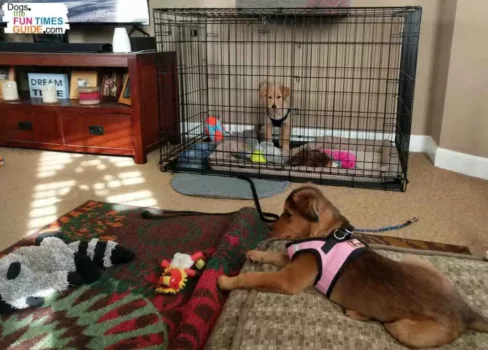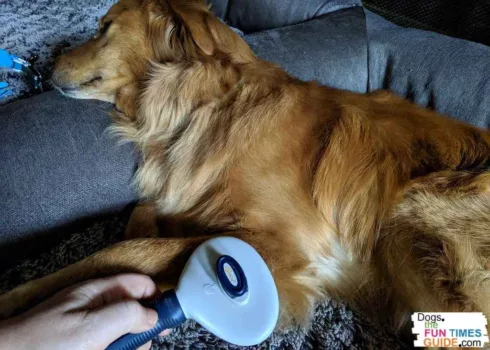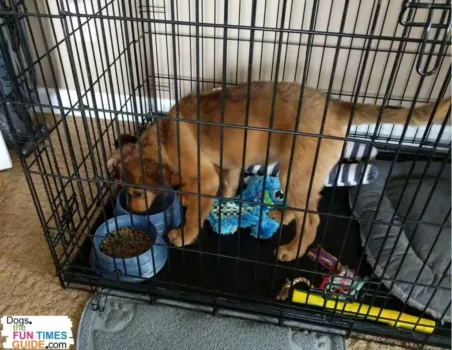Is Littermate Syndrome real? YES.
Most experts strongly advise against raising sibling puppies — because they may become difficult to handle as they mature due to Littermate Syndrome.

I have successfully raised two puppies from the same litter. It wasn’t without its challenges, but it’s not that hard to do yourself.
Following is a summary of what I’ve learned firsthand about preventing Littermate Syndrome.
Find out what you can do to prevent emotional and behavioral issues between any two puppies that are raised together under 6 months of age — whether they’re from the same litter or from different litters.
You will learn:
- What Littermate Syndrome with puppies means
- What can happen when two puppies are raised together
- How to prevent Littermate Syndrome early
- Extra things you need to pay attention to when raising littermate puppies
- Products that make raising two dogs at the same time easier
- Ways to ensure that your sibling puppies thrive independently
What Is Littermate Syndrome?
Littermate Syndrome (sometimes called Sibling Puppy Syndrome) refers to issues that are more likely to arise when puppies from the same litter (or puppies from different litters under 6 months of age) are raised in the same household together.
With Puppy Littermate Syndrome, each dog’s behavior and development is affected in a negative way — which I will describe in detail below.
I’ve heard it said that raising puppies from the same litter is like half the sleep, double the cost, and triple the work! And I would have to agree.
I’ve raised several dogs in my lifetime — from puppies through their senior years.
And I’ve raised two dogs at the same time before. In fact, several times. (Usually, we add a new puppy to our single-dog household during each dog’s senior years.)
But this is the first time that I’ve raised sibling puppies from the same litter. It was a completely different experience! This article summarizes the steps I took — and what worked (and didn’t work) for me.
What Littermate Puppies Are Like
Two sibling puppies raised together are more likely to become:

- Overly attached — to the point that they can become almost unable to function without each other. So, for example, if one has to spend time at the vet, the other may completely melt down or seem uninterested in the things they used to enjoy. Their greatest fear is being alone.
- Fearful of strangers and any other stimuli they are not familiar with (loud noises, other dogs, new environments, etc). They feel safe only when they’re in the company of their sibling. And they might display this fear as anxiety, aggression, or some other nervous behavior.
- Difficult to train — because they have less of a desire to please their human than most puppies do. They’re more interested in each other than in what you (or anyone else) is saying to them.
- More closely bonded with one another than with humans — this is important because how well your dog bonds with you ultimately lays the foundation for your life together, based on: (1) How well mannered they are (willing to learn basic commands). (2) How likely they are to do what you ask them to do (able to avoid repetitive, problem behaviors). (3) How close they are to you and other family members (in terms of giving and receiving affection, companionship, and security).
- Aggressive — inter-dog aggression is common because sibling puppies play hard… and they fight even harder! So any time they have a dispute, it can quickly get out of control. Bullying behavior by the more dominant dog is likely — if the dogs are unable to define their social hierarchy together. Eventually, this type of behavior turns into ongoing aggression between the two dogs. It’s worth noting that sibling pups with inter-dog aggression tend to show hostility towards other dogs as well.
Those are the most common Littermate Syndrome symptoms to watch for when you adopt sibling puppies.
Preventing Littermate Syndrome takes a lot of extra time and patience. I mean, it’s hard enough to raise just one puppy at a time. Raising two puppies together and trying to prevent Littermate Syndrome symptoms from showing up takes a lot of work.
Most experts recommend against getting two puppies that are siblings (or even getting two dogs that are within 6 months of each other in age, from the same litter or not!) — for the reason that their individual growth becomes stunted if they are not separated enough during their first 6 months.
When Puppies Learn Their Place in the Household: At week 12, a puppy’s dominance and submission instincts start coming to the forefront, and he starts to figure out where he fits in the social order of the household. At week 12, the fear stage gives way to curiosity as he becomes more independent and assertive. Now, he needs plenty of reassurance from his loved ones. Usually, pups are secure about their place in the family by about 6 months of age.
— Hill’s Vet
Remember… any two dogs that are 6 months or younger and raised together can develop Littermate Syndrome!
The worst unfortunate outcome of sibling syndrome in puppies is the fact that both dogs’ communication skills and cognitive abilities remain underdeveloped. As a result, they don’t learn how to communicate with others (people or dogs). Nor, do they understand anything outside of what they’ve learned within their litter. They rely 100% on each other to get through life.
So… if you’re getting two dogs, the best thing you can do is bring them home when they’re at least 6 months apart in age. Or, wait to get a second dog until your first dog has turned 6 months of age or older!
How To Prevent Littermate Syndrome (Do These Things BEFORE Your Puppies Turn 6 Months Old!)

If you already have two young puppies, you can reduce the effects of Littermate Syndrome by teaching your dogs to do things separately — completely independent of one another. (It’s best to start this immediately, on day two or three after they arrive in your home, in order to prevent the earliest signs of Littermate Syndrome.)
TIP: The very first time that I introduce a new experience to my sibling pups (like sleeping in a crate, walking on a leash, going for a ride in the car, trying a new human food, playing outside, etc), I always want them to experience it together. It’s not until the second or third time that I start showing them what it’s like to experience that same thing on their own.
These are the things you should do separately when you have two puppies close in age (for the first 6 months):
- Take your dogs on walks separately. This gets them used to going places without their sibling attached at the hip. (Even when we’re not going on a full walk, I often take just one dog with me on a leash to “get the mail.” They both LOVE any opportunity they get to have one-on-one time with me!)
- Take your dogs on car rides separately. At first, it will probably be a very scary thing for them to experience alone. But by taking them to fun places (like the dog park, a walking trail, your kids baseball game), they will start to look forward to these rides.
- Play catch with only one dog at a time. The other can be in a dog crate, a dog playpen, another room, or outside.
- Play with only one dog at a time. You can do this while you’re sitting on the floor with a few dog toys, or sitting on a chair and playing tug-of-war.
- Feed your dogs separately using separate food bowls. You don’t want to be the reason they have food aggression issues! (I have one large automatic dog watering station that separates my two sibling pups’ food bowls. This setup has worked perfectly for us.)
- Train your dogs their basic puppy commands separately. Training them both at the same time takes much longer and is less effective — because you need to have each dog’s undivided attention and be able to give rewards and hugs to only one dog at a time.
- Brush (or groom) only one dog at a time. And… make it clear that the other dog is not invited at this time. (This is how I taught my sibling puppies to love their grooming sessions. Since they both enjoy the one-on-one time they get with me… whether we’re clipping nails, brushing teeth, trimming fur, cleaning ears, getting a bath, or brushing their hair, they sit patiently while I’m doing it. No matter how long it takes!)
- Crate train your two puppies separately. Start by using two separate crates placed near one another at first. Then, gradually increase the distance between the crates — until eventually they can no longer see either other from their own crates.
- Potty train your two puppies separately. Calendar-wise, they can be trained at the same time, but the process of physically taking your dogs outside to pee and poop should be done separately. (One dog should remain in their crate until you’ve taken the other dog outside, given them their treats & praise, and returned them to their own crate.)
- Talk to your dogs separately. Trust me, at first this makes the other dog feel very insecure (because your voice is a form of attention that most dogs crave). When one dog is getting high-pitched, cutesy, baby talk from their human, the other one usually can’t stand it. But the more you do this, the less it’s an issue.
- Go to public places with each dog separately. It’s important to teach each dog to be confident and fearless on their own in a variety of different places. (This is basic puppy socialization 101.)
- Enroll your dogs in puppy training classes separately. Personally, I took my first few dogs to puppy training classes. By that point (and with so much hands-on experience), I had learned enough to train the rest of my dogs on my own throughout the years — even my sibling puppies.

That’s not to say you can’t ever interact with both of your puppies at the same time when they’re less than 6 months old. No way! It’s just wise to spend a lot of one-on-one time with each pup separately and teach them how to live independently of one another as well… that’s all.
TIP: It’s also helpful if one dog can actually see you interacting with the other dog in many of the above scenarios. That way they learn how to cope with the separation from their sibling, and they learn how to be more confident on their own. Trust me, sibling puppies quickly realize that they do not always have to be doing whatever their littermate is doing and that they will still be okay. (Plus, it’s really not possible to teach the basic dog commands to two puppies at the same time anyway — so interacting with them separately actually makes the dog training process much easier!)
A quick read… Easy Tips For Training Two Dogs
Fortunately (for your own sanity and daily time management), doing all of the above things separately with only one dog at a time becomes less important after the 6 month mark. (Whew… right?!)
After your sibling puppies turn 6 months of age, you can slowly begin to do more and more things with them together — rather than separately all the time.
And if you’ve done the puppy training and socialization properly by following the tips above, then your puppies should be able to cope with just about anything independently of the other’s feelings or presence from this point forward!
How To Raise Two Puppies From The Same Litter (Do These Things AFTER Your Puppies Turn 6 Months Old!)
Here are the things you can start doing together when you have two puppies close in age (after the first 6 months):

- Playing with toys and catching balls with them at the same time. My sibling pups listen well when we’re playing and I let them know who I want “get the toy” or “catch the ball.” Whichever dog’s name I say before that phrase is the only one that runs to get the toy or ball!
- Putting their crates closer together. If it would be more manageable for you to move their crates closer together, then go for it. Just do it gradually — at the same pace that you initially moved their crates apart.
- Showing them affection at the same time. By now they should be used to you giving hugs & kisses, carrying one dog in your arms, or letting only one dog on your lap at a time. They should be more accepting of it when you show affection to the other dog in their presence now.
- Receiving treats at the same time. They should be good with being patient at this point. And jealously issues should be minimal.
- Going for a ride in the car at the same time. Car rides should instill a sense of fun and adventure for them.
- Being introduced to new things at the same time. New sounds, different places, strange people, and other dogs.
- Walking on a leash at the same time. At first, it may take some time for each dog to get used to the other one’s pace, but they catch on quickly and become quite easy to walk together — especially when you use a double dog leash coupler.
Raising Two Puppies Together Requires Special Attention To These Things

Every dog deserves their own physical space, their own “things,” and special one-on-one time with you — with extra attention given to their own unique needs and wants.
When you’re raising two puppies, some things should always remain separate, including:

- Crate training — each dog should have their own crate.
- Potty training — until both dogs are fully housetrained, it’s easier if you continue to take them outside to use the restroom, one at a time. Otherwise, they may regress a bit with their potty training — because they’ll be more eager to play than potty!
- Behavior training — obtaining the full attention of one dog is incredibly difficult when the other dog wants to be involved as well. Basic dog training goes much more smoothly, quickly, and successfully when you train two dogs separately. These are the 5 basic puppy commands I used.
- Feeding (but not watering) — your dogs should have their own food bowls, but they can share the same water bowl. Most dogs are not water aggressive or protective of water… just food. Nor should a dog’s access to water ever be limited. (My dogs also share an automatic water spigot outside on the deck.)
- Grooming — this is very valuable one-on-one time that I wouldn’t trade for anything, and now my pups eagerly await their turn. They love the time I spend grooming their nails, teeth, hair, ears, and paws!
Dog Gear & Supplies That Make Raising Two Puppies At Once Easier

With all of my dogs (not just the sibling puppies), I’ve always introduced them to their individual dog crate within the first week that they enter our home. That becomes their “personal space” until they turn 1 year old, at least.
None of them has ever enjoyed being physically separated from us (or from their siblings) and “stuck” in a crate. Not at first. It usually takes 1 to 2 weeks for a dog to get used to their new routine in your home — and appreciate the benefits that come with having their own space:
- Comfort
- Safety & security
- Ability to see everything that’s going on in the room
- Toys
- Warmth
- Food & water
- Sleep
- Pee & poop breaks
…Basically, their entirely new daily routine.

So for their first week, my sibling puppies stayed together in the same large dog crate — first outside on our covered deck until we could properly treat them for fleas, and then in our dining room (which is basically the most central point of our home).
Then, for their first 21 months, they had separate XL dog crates.
After that, they got separate XL dog beds.
See how we chose our puppies, other dog gear and supplies that we’ve found to be helpful when raising two dogs together, and my additional tips for raising two dogs (in general) here.
3 Things You MUST Do When Raising Two Dogs At Once
The Bottom Line When Raising Sibling Puppies…

Firstly, it’s important to note that the simple fact of being littermates does not in itself automatically predispose two puppies that are raised together to developing abnormally (or problematically).
There are many other factors that influence the puppies’ likelihood of developing severe issues — including:
- The puppies’ unique individual personalities, mental health, and physical health
- Their human’s unique personality, mental health, and physical health
- Their human’s ability and willingness to raise the puppies as individuals
Specifically regarding #3 above, I’ve heard it said this way: Don’t make the mistake of treating your two dogs like they are simply one dog with 8 legs and 2 tails! If you don’t treat your puppies as individuals at all times, then you will be far more likely to have some serious puppy behavior issues to deal with before long.
Secondly, it’s important to note that how likely any two puppies are to experience Littermate Syndrome ranges from High (very likely) to Low (not very likely) — it’s on a continuum, rather than a “yes” or “no” thing.
So I just want to be clear that Littermate Sydrome is not a black and white issue. You simply can’t make a blanket statement and say that two puppies raised together will either “have it” or “not have it.”
As I’ve already mentioned, even puppies from different litters that are raised together can have the type of behavioral and cognitive issues that are widely associated with Littermate Sydrome. This happens when the puppies become too attached to one another and share one identity — rather than having clearly defined individual identities and a strong sense of self-confidence.
Thirdly, if you happen to notice that one of your young pups is obviously the leader, to the extent that they even try to “lead” you or “bully” you, then you still have some things to work on.
You should always be seen as the leader to both of your puppies at all times.
Fortunately, this is the case with my two sibling pups. The girl is the dominant one, but she waits for my instruction most of the time. And the boy, who started out extremely submissive, now watches my every move for cues instead of following his sister’s lead every time.
The one exception…

My dominant dog is 100% tuned into me and my cues at all times — but she still gets a little “edgy” if the boy gets affection before she does. If he gets treats first… no problem. If he gets to go outside before her… no problem. But if I reach out to hug him first… she sometimes tries to push her way in for a hug at the same time. It’s a jealousy thing.
TIP: What has worked best for us is to use the phrase “share.” Whenever I say, “Harley, you share,” she immediately takes a step back and waits her turn. At which point I say, “Good share!” They’re both really good at “sharing” (waiting their turn) when it comes to playing with toys, receiving affection, getting treats… just about anything! I’m SO glad that I started doing everything with them separately instead of always as a pair — from their very first days with us. I’m sure that’s why they both wait their turn for things so well now. (And as a bonus: they don’t have self-confidence issues or destructive behavior issues either!)
The Takeaways

If you’re thinking about adopting sibling puppies, just be sure to give some thought to the extra time and effort that it will take training sibling puppies, constantly separating sibling puppies, and getting sibling puppies to live independently of one another!
Two puppies from the same litter (or different litters) raised together during their first 6 months are more likely to:
- Have problems bonding with their human (they bond more closely to one another than to humans)
- Have problems doing things independently of one another (they become hyper-attached to each other)
- Be scared of strangers and other dogs (nervous and fearful of anything outside of their litter)
- Be difficult to train (from potty training to behavior training)
- Be aggressive or display “bullying” behaviors (toward one another, other people, and other dogs)
The degree to which each of the above issues becomes a serious problem varies from dog to dog.
But… with a lot of hard work and patience as a devoted pet parent, you can successfully prevent serious issues due to Littermate Syndrome — like I did with my two sibling pups!
READ NEXT: 5 Basic Dog Commands Young Puppies Need To Know
Like this post? Save it to read again later… or share with others on Pinterest!

I like to help Dog Parents find unique ways to do things that will save time & money — so I write about “outside the box” Dog Tips and Dog Hacks that most wouldn’t think of. I’m a lifelong dog owner — currently have 2 mixed breed Golden Aussies that we found abandoned on the side of the road as puppies. I’ve always trained my own dogs and help friends train theirs, as well. Professionally, I worked at a vet and have several friends who are veterinarians — whom I consult with regularly. (And just because I love animals so much, I also worked at a Zoo for awhile!) I’ve been sharing my best ideas with others by blogging full-time since 1998 (the same year that Google started… and before the days of Facebook and YouTube). My daily motivation is to help first-time dog owners be better prepared from the first day your new puppy enters your home. I like to help dog owners understand what’s ‘normal’ and what you can expect in terms of living with and training your dog — how to get through the ups & downs of potty training, chewing, teaching commands, getting your dog to listen, and everything else that takes place during that hectic first year! When I’m not training, walking, grooming, or making homemade treats for my dogs, you will find me at the corner of Good News & Fun Times as publisher of The Fun Times Guide (32 fun & helpful websites). To date, I’ve written over 600 articles for dog owners on this site! Many of them have upwards of 200K shares.





